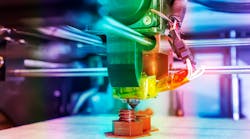By Philipp Jung
As we close another year of progress in 3D printing, it’s an ideal time to take a moment to predict what innovations will unfold in the year ahead.
The widely followed 2019 Wohlers Report predicts worldwide spending for all 3D printing products and services will hit $15.8 billion in 2020 and continue to accelerate, reaching $23.9 billion in 2022 and $35.6 billion by 2024.
This market expansion is largely the result of improvements in 3D printer technology, including higher parts quality, manufacturing-grade accuracy and repeatability, as well as an expansion of available materials. In addition, 3D printing solution providers are using machine learning (ML) for heightened process control. All of this has resulted in significantly better Overall Equipment Effectiveness (OEE) and larger addressable markets
Manufacturers across industries are now imagining new ways to apply this technology, first and foremost with an eye toward personalization. Think, electric cars and buses in automotive; prosthetics, orthotics, dental care and organ modeling in life sciences; custom shoes, belts, jewelry and eyewear — you name it — in consumer goods, all personalized and all improved by the lightweight durability of 3D printed parts. Beyond lightweighting, 3D printing can also improve parts and product performance through better fluid management and energy absorption.
Bold manufacturers are beginning to “think in 3D” from the outset. Consider these recent examples of major industries using the technology in real ways.
Automotive
One of the most urgent transportation demands is the need for more electric vehicles to lower emissions and move people quickly and efficiently. Volkswagen who is among the leaders with the ID.3 — the automaker’s first mass-market electric vehicle—will eventually utilize 3D printed components. More broadly, many major automakers, including BMW, Jaguar Land Rover, are also piloting or deploying 3D printing technology to trim vehicle weights, speed parts production and reduce costs.
There’s also Olli, an unusual self-driving bus that started rolling around Sacramento State University earlier this year. Almost entirely 3D-printed, it is capable of transporting about eight people and reaching peak speeds of 25 mph while going up to 100 miles on a single charge. Olli is no speed demon, to be sure, but it has successfully demonstrated the ability of 3D printers to produce strong, lightweight components for road-worthy use cases.
3D printing is also finding a home on the racetrack. Like many automotive racing teams, Triple Eight Race Engineering, an Australian company that competes in the Virgin Australia Supercars Championship, builds the cars it uses. In the past, Triple Eight said it would have to machine its automotive components from a block of aluminum, which was expensive, time-consuming and heavy. Or it would have to use billet plastics, which were considered messy and also time-consuming. With 3D printing, they can produce very detailed parts that are strong, light and able to withstand harsh racing environments, which they consider “game changing.”
So much is occurring in the auto industry that it’s not difficult to predict automakers will continue to unlock opportunities for using metal and plastic 3D printing systems next year. In fact, a recent ARC report projects the automotive 3D printing market will experience a compound annual growth rate (CAGR) of 24.6% through 2026, when it will be worth $3.9 billion.
Medical
Nowhere are the possibilities for 3D printing more incredible than in the medical field. Indeed, medical applications could be considered prime for customization since every individual is unique and could benefit from technology capable of tailoring solutions to their own anatomy.
Take prosthetics, for example. The World Health Organization estimates there are about 30 million amputees worldwide, with most of those in developing nations with no access to artificial limbs. Enter companies like Unlimited Tomorrow. At CES 2020, the New York startup, founded by a young inventor named Easton LaChappelle, unveiled a 3D-printed prosthetic arm for kids customized to match a patient’s skin tone. There’s also iOrthotics, an Australian company using the 3D printers to manufacture tens of thousands of pairs of custom orthotics and braces each year. The company says 3D printing has enabled it to shave weeks off the old process for getting people back on their feet. iOrthotics also says 3D printing has drastically reduced its waste output.
Also in the medical field, researchers from Rensselaer Polytechnic Institute in New York and Yale School of Medicine reported they’d successfully joined cells from human blood vessels with animal collagen and other ingredients to 3D print a skin-like material. The advancement could lead to creating grafts that are more like our own skin and be hugely valuable for hospital burn and infectious disease units. Plus, 3D printing is creating interactive and personalized anatomical models to use before difficult surgeries. Doctors, including those at Rady Children’s Hospital in San Diego, essentially capture images of afflicted patient organs (hearts, spines, skulls and so on) using 3D technologies like MRIs and CAT scans. From those, they then produce highly accurate 3D printed physical renderings — one layer at a time — of those organs in order to better visualize how they will approach their operations.
As with automotive, the global 3D printing healthcare market is seeing such progress that it is likely to continue expanding in 2020 and beyond. In fact, Allied Market Research predicts it will reach $2.32 billion next year, with a CAGR of 26.2%.
Dental
When it comes to personalization driven by 3D technology, look no further than the dental industry. 3D printing is increasing safety by enabling dentists to do detailed imaging of patients’ mouths from the inside instead of the outside, lessening exposure to radiation.
3D printing can also cost of orthodontia, sometimes by as much as 60%, with custom 3D-printed mouth molds. One of these providers, Smile Direct Club, says that 3D printers allow them to make more than 50,000 aligners in a single day. They’re also able to recycle molds once they’ve been used and turn that material into pellets for injection molding.
According to Data Bridge Market Research, the dental 3D printing market is expected to grow at a rate of 21.6 percent between 2020 and 2027, by which time it’s predicted to be an $8.7 billion industry.
Of course, as the industry continues to evolve, not everyone will necessarily know when they’ve come in contact with 3D printed car or medical parts, but it’s easy to predict most will realize 3D printing’s wonders in some form or another. Numerous reports suggest 3D printing will continue its impact in consumer goods next year as retail manufacturers, from sporting goods to jewelry, explore new direct-to-consumer models for delivering newer products.
As we look to 2020 and beyond, 3D printing technology and materials are likely to continue to improve, presenting important market opportunities for manufacturers. But the key to success will likely be in how they take advantage of all of this change. Accomplishing that will require thinking in new 3D terms to address the entire production lifecycle — from parts and product design to prototype and full production — and changing how the world designs and manufactures.
Philipp Jung is SVP and global head of Vertical Industries & End-to-End Applications for HP’s 3D Printing and Digital Manufacturing business.




